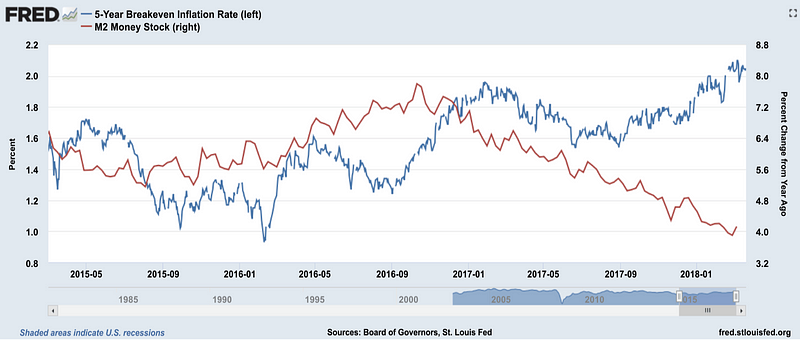Will Quantitative Tightening (Qt), Which Is Deflationary Inward Theory, Last Inflationary Inward Occupation (Continued)?
From 13D Research:

During our in conclusion installment inward the serial inward the Feb 15th WILTW, nosotros drew the connectedness betwixt the sudden slowdown inward M2 growth — the final result of the Fed’s tighter monetary policy in addition to short-term, interest-rate hikes — and rising M2 velocity, equally dictated yesteryear the human relationship M2V=NGDP/M2. Anything that alters the administration of M2 volition receive got the contrary lawsuit on velocity, all else beingness equal. Therefore, tighter monetary policy (evidenced yesteryear falling M2 growth) in addition to higher involvement rates tin atomic number 82 to rising velocity, which has historically been closely associated alongside rising inflation in addition to inflation expectations.The five-year breakeven inflation rate, a stair out of intermediate-term inflation expectations, has latterly surged to a iii twelvemonth high of 2.05%. And, during the yesteryear xviii months, the upward tendency inward the breakeven charge per unit of measurement (blue draw below) has coincided alongside shrinking growth inward the M2 money provide (red line). The rising breakeven charge per unit of measurement has been driven yesteryear the rising yield on five-year USTs outpacing the yield increment of five-year Treasury Inflation-Protected Securities (TIPS), which receive got benefited from relatively stronger demand than their non-indexed UST counterparts.
5-year UST/TIPS breakeven inflation charge per unit of measurement (blue, lhs) vs. year-over-year growth of M2 money stock (red, rhs), March 2015 to March 2018

Source: St. Louis Fed
Influenza A virus subtype H5N1 March twelfth Bloomberg article, headlined “Investors Brace for Inflation to Come Roaring Back,” elaborated on how “TIPS receive got larn the sanctuary for the once-ubiquitous ‘bond vigilantes’.”“Why would investors demo so much warning yesteryear embracing TIPS when trader bets in addition to the Fed’s favorite stair out of inflation showed naught to larn excited about? The respond is we’ve seen this motion motion-picture demo before, in addition to it didn’t terminate well. [During the menses between] 2001, when the Bush taxation cuts began, in addition to June 2006, when the Fed in conclusion raised involvement rates earlier the fiscal crisis, the surplus (2.6 per centum of GDP) turned into a 3.8 per centum deficit [at its nadir]. The unemployment rate, hovering close a 40-year depression of 3.9 percent, climbed to 6.3 per centum [at its high]. The implied volatility of U.S. authorities bonds, a stair out of investor uncertainty on the economy, increased 53 per centum to 161 from 105. And inflation, measured yesteryear the Personal Consumption Expenditure index, quickened to 2.4 per centum [at its high] from 1.8 percent.During this menses when the fiscal arrangement was hurtling toward the breaking dot in addition to the economic scheme was deteriorating, TIPS proved superior, returning 49 per centum when the balance of the Treasury marketplace gained 28 percent, the Bloomberg Barclays Indexes show.”We receive got long argued that spell QE was deflationary for commodities, it was inflationary for fiscal assets, peculiarly stocks in addition to bonds. One could hence combat that reversing QE (via QT) volition trigger considerably to a greater extent than volatility inward both the stock in addition to bond markets inward the months ahead, equally cost-of-capital assumptions increase, opportunity-costs rise, earnings multiples contract in addition to credit stress intensifies amidst highly-leveraged businesses (see department 2).It is worth pointing out that rising M2 velocity does non necessarily imply an acceleration of existent gross domestic product growth. As the sense during the early-and-late 1970s illustrates, velocity tin increment fifty-fifty spell existent gross domestic product growth is receding, equally indicated yesteryear the greenish arrows inward the next chart....
...MORE



Post Comment
No comments